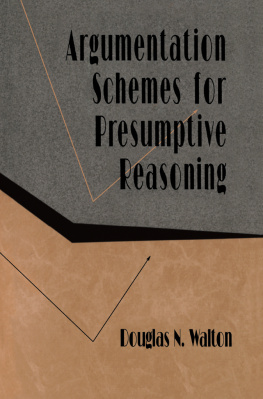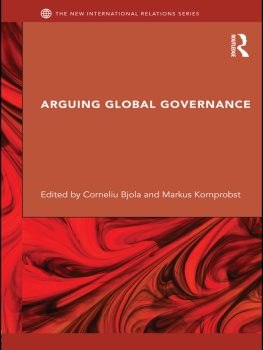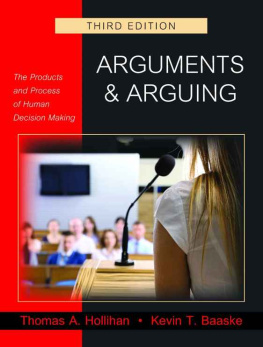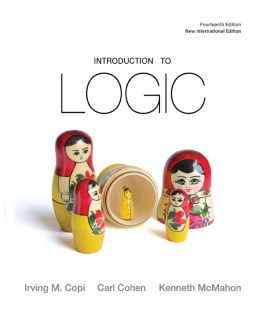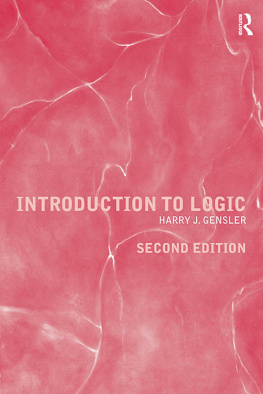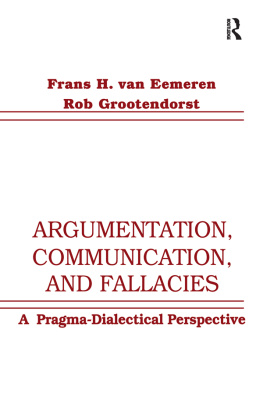Argumentation Schemes for
Presumptive Reasoning

First Published by
Lawrence Erlbaum Associates
10 Industrial Avenue
Mahwah, NJ 07430
Transferred to Digital Printing 2009 by Routledge
270 Madison Ave, New York NY 10016
2 Park Square, Milton Park, Abingdon, Oxon, OX14 4RN
Copyright 1996 by Lawrence Erlbaum Associates, Inc.
All rights reserved. No part of this book may be reproduced in any form, by photostat, microfilm, retrieval system, or any other means, without the prior written permission of the publisher.
Cover design by Gail Silverman
Library of Congress Cataloging-in-Publication Data
Walton, Douglas N.
Argumentation schemes for presumptive reasoning / Douglas Walton.
p. cm.
Includes bibliographical references and index.
ISBN 0-8058-2071-X (alk. paper). ISBN 0-8058-2072-8 (alk. paper)
ISBN 978-1-136-68705-1 (ePub)
1. Hypothesis. 2. Presupposition (Logic) 3. Reasoning. I. Title.
BC183.S25 1996
168dc20
95-20169
CIP
Publishers Note
The publisher has gone to great lengths to ensure the quality of this reprint but points out that some imperfections in the original may be apparent.
For Karen, with love.
TABLE OF CONTENTS
As a member of a research group on Fallacies as Violations of Rules of Argumentative Discourse at Netherlands Institute for Advanced Study in the Humanities and Social Sciences (NIAS) in 1989-1990, the author heard a lot of talk about argumentation schemes as the glue that holds argumentation in a critical discussion together, making it reasonable. But, what are these argumentation schemes and where do you find them? Frans van Eemeren, in answer to these questions, said that they are found in the (1963) doctoral dissertation of Arthur Hastings. This, indeed, did turn out to be the best source of material on argumentation schemes, called modes of reasoning by Hastings. Although Hastings account was incomplete, and insufficiently structured to be as useful as one would like (in the current state of the art), it proved to be the most helpful treatment of argumentation schemes, in the scant literature on this subject.
My own previous research in the field of argumentation has been in the area of informal fallacies. It seems to be a recurrent pattern with these fallacies that the basic tool required to work out an analysis of the fallacy is some kind of argumentation scheme, or structure of inference underlying the fallacy. It seems that to understand the fallacy, or incorrect (erroneous) argument, you first of all have to understand the correct type of argumentation that was abused or misused.
The basic problem with many of the traditional examples of the informal fallacies given in textbooks is that they are not clearly fallacious. Indeed, in many cases, arguments of the same kind as that identified with the fallacy are quite reasonable, provided we lower our standard of what is a reasonable argument by including presumptively reasonable arguments. These are inconclusive and defeasible arguments that nevertheless have a practical function of shifting a burden of proof in a dialogue. This notion of presumptive reasoning will be defined dialectically in . But for the present, we need to see that an argument can be weakly or presumptively reasonable, even if it is inconclusive, and yet not be a fallacious argument.
Many of the fallacies are misuses of presumptive inference, a kind of reasoning that is neither knowledge-based nor probability-based, but has the function of shifting a weight of presumption onto the other party in a dialogue. Presumptive inference has been analyzed in Walton (Plaus. Arg., 1992), and this research is extended and applied to argumentation schemes in . Presumptive inference has been in the past systematically ignored by logicians, but it is the basis of kinds of argumentation that are very common in everyday arguments like the argument from sign, the argument from consequences, and the appeal to expert opinion in argument. The analysis of forms of these kinds of arguments is the subject of this book.
A good example is the use of appeal to authority in argumentation. Appeal to expert opinion in argument has, especially during some historical periods, been rejected as inherently fallacious. However, currently, with the advent of expert systems as a practically useful technology, the trend is to accept appeal to expert opinion as a legitimate kind of argumentation. But what kind of argument is it? The best answer is that it is a presumptive kind of argumentation which can correctly be used in a context of dialogueexpert consultation dialogue, a species of information-seeking dialogueto shift a weight of presumption for or against a proposed course of action in practical reasoning. The presumption is shifted back and forth in dialogue, depending on whether critical questions to the argumentation scheme are properly raised or adequately replied to. When expert consultation dialogue is adjoined to critical discussion correctly in a form of dialectical shift or mixed dialogue, the appeal to expert opinion can be correctly used to support an argument advanced in the critical discussion.
This type of argument can be used to support the goals of a critical discussion by making the discussion informed and up-to-date, with scientific developments for example. Such a mechanism enables the carefully solicited opinion of an expert to be reasonably, if tentatively, accepted by non-experts for the sake of argument in a critical discussion without stifling the discussion or delaying it by holding an extensive scientific inquiry into a body of evidence that may be massive, sophisticated and specialized. Presumptions are something we could hardly do without in everyday arguments, for without them, a discussion would be stultified by endless calls for lengthy inquiries.
Presumptions are shifted back and forth in dialogue through the filter of an argumentation scheme, a formal pragmatic structure of arguments that is the counterpart to logical forms of inference in semantics. The concept of an argumentation scheme was originally developed by Hastings (1963), who postulated several types of schemes that are highly relevant to the study of fallacies.
In view of our interest in the argumentum ad verecundiam as a fallacy, Hastings ninth argumentation scheme, for the argument from authority, provides a relevant example of how an argumentation scheme functions. Note that Hastings saw the argument from authority as (in principle) a reasonable kind of argumentation. Hastings saw it as a form of sign reasoning of the following kind: the fact that a speaker asserts a conclusion is taken (by a hearer) to be a sign that the conclusion is true.
As an example of the argument from authority, Hastings cited the following argument.
Case 0.1: The first concerns the ability of these nations to obtain these nuclear weapons. We suggest that they certainly do have this ability, that many nations have come into the ability in recent years. The London Disarmament Conference, in its follow-up report in 1957, saidand I note this opening phraseOn their own without outside help the following nations can achieve nuclear weaponsa long list followsBelgium, Canada, Sweden, Switzerland, France, Japan, India, Italy, Argentina, West Germany, Egypt, Israel... and many other nations. We note that many sources, such as the Senates Disarmament Sub-committee, have all echoed this very important and very strategic possibility, (p. 126)
According to the analysis given by Hastings, the conclusion of this argument is that (probably) these thirteen nations can get nuclear weapons on their own. To prove this conclusion, the speaker presents an authority that says it is true, and backs that up by citing (without direct quotation) another authority who is said to agree.
Next page
